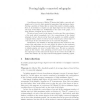Free Online Productivity Tools
i2Speak
i2Symbol
i2OCR
iTex2Img
iWeb2Print
iWeb2Shot
i2Type
iPdf2Split
iPdf2Merge
i2Bopomofo
i2Arabic
i2Style
i2Image
i2PDF
iLatex2Rtf
Sci2ools
JGT
2007
2007
Forcing highly connected subgraphs
A well-known theorem of Mader [5] states that highly connected subgraphs can be forced in finite graphs by assuming a high minimum degree. Solving a problem of Diestel [2], we extend this result to infinite graphs. Here, it is necessary to require not only high degree for the vertices but also high vertex-degree (or multiplicity) for the ends of the graph, i.e. a large number of disjoint rays in each end. We give a lower bound on the degree of vertices and the vertex-degree of the ends which is quadratic in k, the connectedness of the desired subgraph. In fact, this is not far from best possible: we exhibit a family of graphs with a degree of order 2k at the vertices and a vertex-degree of order k log k at the ends which have no k-connected subgraphs. Furthermore, if in addition to the high degrees at the vertices we only require high edge-degree for the ends (which is defined as the maximum number of edge-disjoint rays in an end), Mader’s theorem does not extend to infinite gra...
| Added | 15 Dec 2010 |
| Updated | 15 Dec 2010 |
| Type | Journal |
| Year | 2007 |
| Where | JGT |
| Authors | Maya Jakobine Stein |
Comments (0)

